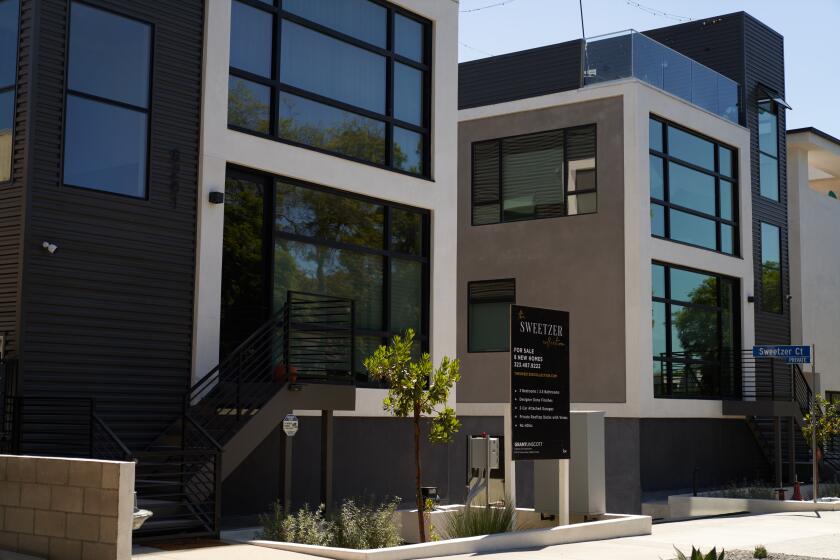L.A. County could have 1.7 million fewer people by 2060. It’s not only because residents are leaving

When imagining Los Angeles in 2060, scenes of flying cars, AI celebrities roaming the streets and maybe an additional transit line or two might come to mind.
Projections from the state Department of Finance underscore a different future — with fewer people living in L.A. County than are currently here now.
Recently updated population projections show the county losing over 1.7 million people between now and 2060, a decrease of more than 17% from the current total of around 10 million.
Jonathan Drazan, 28, lives in Long Beach and plans to be in Southern California long term. When asked to imagine L.A. 37 years from now with far fewer people, the affordable-housing developer chuckled. “The first thing that comes to mind is less cars on the road, on the highways, hopefully a little less traffic on the 405-10 intersection.”
He added that fewer people might also mean less competition for housing.
“I’m not hoping people move, but if they do, it might not be the worst thing for the city,” Drazan said.
Statewide, the population is expected to remain flat during the same time-frame, with low birthrates and net migration out cited as the main factors in the projection.
California has been growing steadily since its birth in 1850, and prolonged population stagnation would represent a radical departure.
L.A. County, the state’s largest, is expected to lose far more people in total numbers than any other county. The county is forecast to lose a higher proportion of its population than all but six others — all of which currently have under 50,000 residents.
The shift can be explained by a “continuation of the trends we’ve seen,” explained Andres Gallardo, a demographer with the Department of Finance.
Subscriber Exclusive Alert
If you're an L.A. Times subscriber, you can sign up to get alerts about early or entirely exclusive content.
You may occasionally receive promotional content from the Los Angeles Times.
The data predicts a steep drop off in births “as L.A. gets older, because fertility is very tied to age,” Gallardo said.
Citing data from the California Department of Public Health that showed a 20% reduction in births in the county from 2016 to 2021, he noted that lower birthrates now can compound over time to significantly affect population, resulting in future generations shrinking.
Gallardo noted that declining birthrates are an international trend and not confined to the Golden State. What is more pronounced here, though, is net migration out of major cities, a phenomenon associated with high housing costs in Los Angeles County and the prevalence of remote work.
Another factor — the drop in legal immigration — may also be dampening the outlook for California’s population.
“On a per-million basis, California usually ranks in [the] top five” for lawful permanent residents, Gallardo said, so national policies limiting immigration have an outsize impact on the state.
A rural California school district scrambles to find teachers amid a national shortage. It will not offer transitional kindergarten, despite a new law.
The model shows growth expected in the Central Valley, which includes cities such as Stockton and Merced, even as much of the rest of the state stagnates or shrinks.
“We don’t expect the population to age as quickly,” Gallardo said of the comparatively young residents of the Central Valley, noting that young people have more children and are less likely to die.
The Central Valley also has what L.A. does not: room to grow, said Kome Ajise, executive director of the Southern California Assn. of Governments, a group which uses the Department of Finance projections to help their own decision making and modeling for the future.
“The L.A. Basin is getting to critical mass” of people, Ajise said, noting that it is near its “carrying capacity” and will have trouble adding the housing required for its population.
In contrast, the Central Valley, like Southern California’s Inland Empire, “still has room to grow.” However, building housing in farming areas like the valley involves trade-offs. New home construction often replaces working farms, he said, adding “land is zero sum.”
One of the big drawbacks to a population surge in the Central Valley is the punishing heat waves endured by the region.
In San Joaquin County, where population is expected to grow by 25% by 2060, the forecast high temperature for this Sunday is 106 degrees. Given the harsh realities of climate change, the Central Valley and other areas in warm climates could be much less hospitable for human life in the decades to come, experts say.
Ajise believes those moving to the Central Valley now are often influenced by more immediate factors like current housing costs, and may not be factoring in climate change in the future. But that may be creating an uneasy reality — the state is adding housing and population in places that may not be sustainable long-term.
Zillow data show the median list price for homes in Los Angeles fast approaching $1 million. The top 10 major metropolitan areas in America for median listing price in June were all in California, according to a Times analysis.
SCAG does not agree that the population declined projected by the Department of Finance for Southern California will “be that dire,” said Ajise.
Though population decline has been the rule for the past three years, he noted that the region added nearly 150,000 new housing units in that span, and nearly 500,000 new jobs since 2016.
SCAG instead projects modest growth in Southern California over the decades to come — still less than booming states such as Texas, but far above the population losses predicted by the finance department.
Though major urban areas like L.A. may deter future growth with such obstacles as high housing costs, Ajise said, competing cities such as Austin, Texas, and Boise, Idaho, are seeing rising costs too.
“We’re still an immigrant gateway,” he said, and “the region is still thriving.”
Drazan, for his part, sees potential upside to a future population decline. There could be “general benefits to the city in having less strain on the infrastructure,” he said, and fewer people would mean less competition for housing.
“It’d make it a little easier to survive in L.A. for the average working-class person if rents went down,” he said.
Subscribers get early access to this story
We’re offering L.A. Times subscribers first access to our best journalism. Thank you for your support.
In Drazan’s vision of Los Angeles in 2060, he also sees a future with less of the region’s infamous traffic.
“Hopefully the Dodgers win a World Series or two by then,” he said. “If nothing else I could get a little closer for the parade.”
More to Read
Subscriber Exclusive Alert
If you're an L.A. Times subscriber, you can sign up to get alerts about early or entirely exclusive content.
You may occasionally receive promotional content from the Los Angeles Times.













